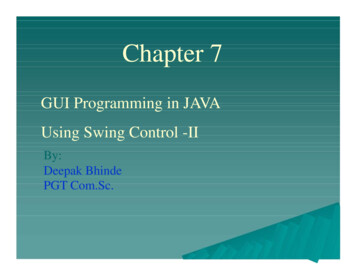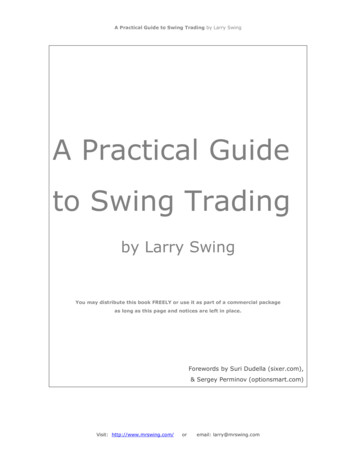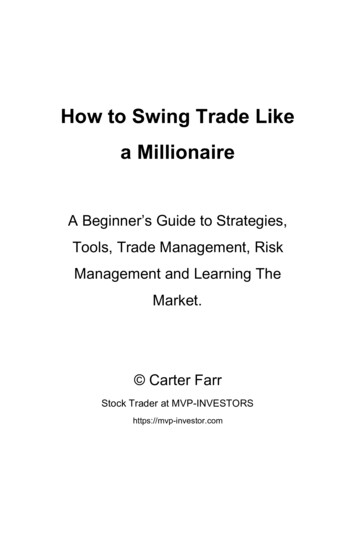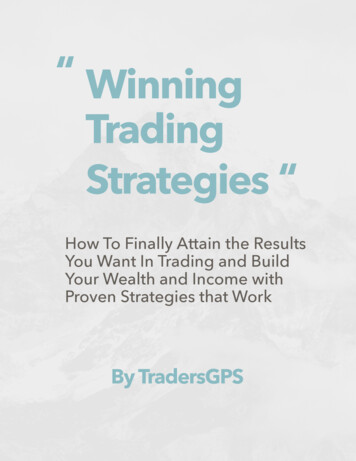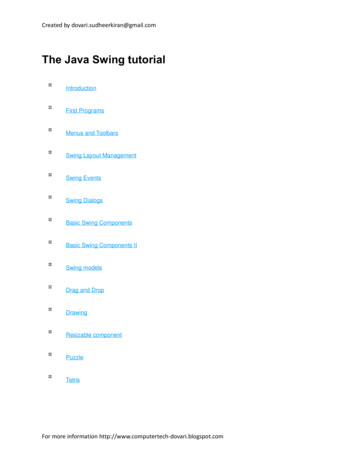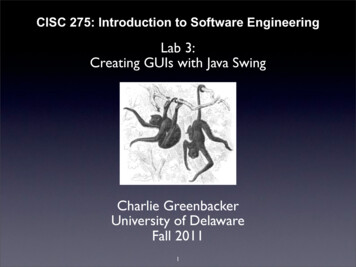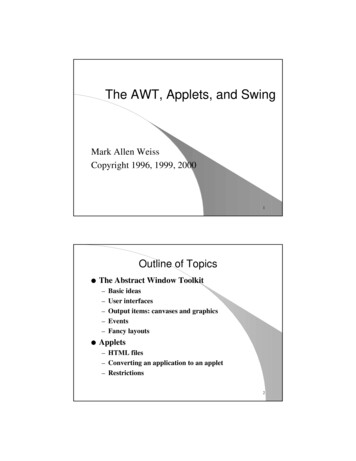
Transcription
COPYRIGHT 2017 JASON BONDAll rights reserved.ISBN: 978-1-61961-796-4
I’d like to dedicate this book to my loving wife, Pamela, whose ongoing support helped make all of thishappen, and to my good friend and business partner, Jeff Bishop, who taught me everything I know abouttrading stocks and building businesses.
CONTENTSFOREWORDINTRODUCTION1. REFUSE TO ACCEPT THE STATUS QUO2. BE HONEST ABOUT WHERE YOU STAND3. GAIN THE COURAGE TO LEAP4. GO ALL IN5. SURROUND YOURSELF WITH THE BEST6. LEARN THE GAME7. MULTIPLY YOUR WINS8. CONCLUSIONABOUT THE AUTHOR
FOREWORDBY KYLE DENNISI started college at UCLA in 2008, intending to become a doctor, but switchedcareer paths and graduated in 2012 with a biology degree and 80,000 in studentloans. My first job as a real estate acquisitions analyst brought in 35,000 a yearand, clearly, driving down my loan debt was going to be impossible on thatsalary.While in college, I made a few stock trades in a 1,500 account. One cheappenny stock bombed and went to zero, but another I traded went up 50 percent.This intrigued me, so I became more active in researching biotech stocks bydrawing upon my biology knowledge. I was just trying to make some money totravel the world with my family and save a little for my future, and neverthought I’d ever trade stocks as a profession.When I met Jason Bond, that all changed.I joined JasonBondPicks.com with a 15,253 trading account and startedlearning his strategies. Under his guidance, I had two good years of trading—with 36,901 profit in 2013 and 55,468 profit in 2014. I wasn’t exactly on fire,but I was learning that because of Jason’s prior ten years as a schoolteacher, hewas very good at breaking down the complexities of Wall Street in simple terms.His passion for giving his members the training to make profits as a stock tradercame shining through in everything he did.When I invested the money to become a member of Jason’s MillionaireRoadmap community, I began learning even more from him, and my accountjust exploded. I made 847,417 trading profit in 2015, 1,130,566 profit in 2016,and was up 1,022,522 in the fall of 2017. Those 2016 numbers were enough forme to win a contest on Jason’s site offering an incredible prize for his firstmember to reach 1,000,000 in profits.A brand-new Porsche sports car.I knew Jason was a stand-up guy, but in reality, people usually don’t just give
away brand-new Porsches. I will admit to being a bit skeptical, but after heaudited my trading accounts to confirm I had indeed passed the million-dollarmark in profits, he invited me and twenty or thirty of his other MillionaireRoadmap members to Las Vegas for a little ceremony. That was actually the firsttime I’d ever met him in person, and he was all that he said he was—fired up tomake money, and eager to show others how he does it so they can get in on theaction. My mom came to Vegas and drove my brand-new black Porsche 911convertible home to Los Angeles.Who does that—gives people free sports cars?Jason Bond did.I’ve recently partnered with Jason and his company cofounder, Jeff Bishop, todevelop my own company and newsletter, BiotechBreakouts.com, which is ontrack to become a 10 million company in its first year. Jason brings significantexperience to our new venture, as a mentor and business builder, and togetherwe’ve grown my Nucleus Program membership, offering a similar service toJason’s, only focused on biotech stocks.Jason Bond is hyper-focused on one thing: teaching people to make moneythrough swing trading. Now he’s helping me teach people to successfully tradebiotech stocks. He’s so confident that the strategies he taught me will transfer tomy members so they can achieve success as traders that he’s going to buysomething special for the first one of them to hit 1,000,000 in trading profits.He’s going to buy them a Porsche, just like the one he bought me.Who does that?—KYLE DENNIS
INTRODUCTIONThat one line of red ink hit me like a shovel against the side of my head.It was a number so obscene I could hardly believe my eyes. In retrospect, it tookthat severe blow—if only a metaphor—to wake me up and push me to begin aquest to reevaluate my life, a journey that has allowed me to go from beingburied in debt to building a financial portfolio of more than 7 million as aswing trader and stock-trading mentor.I was doing my taxes one year, using a free copy of Quicken. I’d dropped in thenumbers from the W-2s for myself and my wife, hoping for a nice tax refund. Asa pair of well-educated and dedicated teachers, we were thrilled about theprospects of receiving a tidy check for a few thousand dollars, because everyonelikes a tax refund, right?That excitement evaporated instantly, though, when I saw the software’s reportthat said we had a net worth of negative 250,000! We were bleeding red ink,and I didn’t know why. Shocked and stunned, I simply couldn’t accept that afterseven years of college and a successful teaching career in the New York Stateschool system, our net worth was not just zero—it was far below that. It was anembarrassing moment that prompted some serious personal reflection.After I researched what “net worth” actually is, it started to sink in that with thedebt we were both carrying—even with twenty-four years left as teachers beforea comfortable retirement—there was no way to build the kind of wealth thatwould give us the financial freedom to have a comfortable life now and inretirement. In fact, I saw no clear path to even eliminating the mountain of debtwe had amassed because of a mortgage, student loans, car loans, credit cards,and personal loans. We knew that the idea of preserving the status quo was notsustainable going forward.Something had to change.I was looking for answers when a friend recommended I read Dave Ramsey’sbook and buy his course. Ramsey’s main message was that to position yourselfto build wealth, you first need to pay off all of your debts, starting with thesmallest one in order to build some momentum. As two people who have always
worked exceptionally hard at everything we did, we found that Ramsey’s mainthesis about doing whatever you have to do to pay off all your debt resonatedwith us. If we truly wanted to get out of debt and erase that red ink from ourlives, we quickly learned that we needed to find some creative ways to earn onebuck, and then another, and another.As you will read about in the beginning of each chapter of this book, paying offour debts meant making some hard choices and doing things many people mightnot be willing to do. Scrounging through a trash bin for soda cans after the highschool football game may sound extreme, but that’s what we did in order to findtwenty dollars to fill our used car’s gas tank. If there were twenty-four hours ineach day, those hours represented valuable time to work, earning anything wecould to put toward paying down one of our fifteen debts.By following Ramsey’s advice, we eventually ended up at zero net worth withno debt after four years of following his plan. Sure, it still was not the sort ofwealth we both envisioned, but we had eliminated 250,000 in obligations fromour lives, and that opened the door to begin exploring other paths to a solid andwealthy future. I woke up every morning as a teacher thinking about how I couldleverage my talents as an educator to make something big happen; and then Imet Jeff Bishop, and my “something big” fell into place.Jeff Bishop became my mentor, but also my best friend. He’s the guy who taughtme what I know today, and he’s also now my business partner. I was looking forsomeone who could teach me how to trade stocks, but I knew I never wanted tobe a full-time trader. He helped me understand what my path forward was goingto look like, but there was one major problem:I was still a full-time teacher.As my story unfolds in this book, you’ll read that getting out of debt was aprerequisite to moving on to bigger and better things. Before I could embark onmy current journey of teaching others to be successful swing traders, I first hadto dig deep and find the courage to go all in. I had to find a way to align myselfwith the concept of drastically changing course after devoting seventeen years tobeing the best teacher I could be.The end result I wanted was clear, but the questions were enormous: Did I want
to make the giant leap from the safe confines of teaching and coaching sports fora school to being a full-time stock-trading mentor and newsletter publisher? Wasthis a fool’s move? Would I crash and burn, or light the world on fire? Was Iputting my family’s future finances in jeopardy?The answers to these incredibly difficult questions will be presented in theupcoming chapters as I lay bare my personal quest, with all the drama,trepidation, and triumphs that come from taking a courageous leap off anentrepreneurial cliff. I am writing this book to the many people out there whocurrently are where I was at one time: not satisfied with the status quo, anddeeply conflicted about what to do about it.After reading my seven steps needed to attain financial freedom in the followingchapters, you will learn just how to take that first step into what might seem likean abyss. I assure you it is not, and I’m honored that you have allowed me intoyour life so I can give you the tools needed to become a successful swing traderand achieve the kind of financial independence you have always desired,whatever that may be.So let’s get to work and take those first steps together.
Chapter 11.REFUSE TO ACCEPT THE STATUS QUOThe school district I worked for in my ninth year of teaching had a long-standingpolicy to allow teachers to take a leave of absence to explore something new—like starting a business, for instance. After realizing I would never achieve thelevel of wealth I wanted for my family, I went in and told the superintendent thatI didn’t think I could be a teacher anymore. I requested a leave of absencebecause my gut feeling was that I needed to check out some other things outsidethe realm of public education.I was honest with the school district, but might not have been honest withmyself. During my leave of absence, I did some stock-trading and financialwriting, but it did not feel right, even though I gave it everything I had byworking long hours, and even though I looked for every opportunity to make my“next big thing” happen. I soon realized it was hard to live as an entrepreneur,and our personal finances became increasingly unstable. Surviving without thesecurity of my teaching job started to get to me.One morning while out on leave, the superintendent called me to ask if I wantedto come back to teaching. He had a position for me, one that would againstabilize our finances. I decided to take the job, but after two months, I startedfeeling shitty about giving up on working for myself so quickly. I’d only spentsix months on my own trying to start a business before running back to teaching.Had it been a mistake to leave behind seven years of college and nine years ofteaching to chase a dream? Was it even a dream, or was it just magical thinking?I was in a conflicted place, because I didn’t think six months was sufficient timeto build the kind of business I’d envisioned. I knew I could always go back toteaching, and that safety net was taking the edge off the survival instinct Ineeded to succeed.
I loved working with kids, and working with them in physical education gave megreat joy. Something big was gnawing at me, though. Did I see myself doing thisfor the next thirty years? The answer was clear; I knew I couldn’t do it anymore—I wasn’t happy. We had just worked for four years to pay off all of our debt.The student loans were gone; the personal loans were history. We had sold ourmodest ranch house and were living in a small apartment. My wife had waitedtables and I had done roofing work, on top of our teaching jobs. We both suckedit up and successfully removed the red ink from our balance sheet.All should have been fine, but it wasn’t.Without debt, we found ourselves soon looking at more expensive homes to buy.We were making more than 100,000 together as teachers and were looking athomes well north of 200,000. It was disappointing, because I felt as if we wereon the verge of slipping right back into debt. Between coming off the leave ofabsence and contemplating going back into debt, I again felt as if the door to thewealth I wanted was closing and we were taking a huge step backward.It was a dark time for me, and I knew I had to act; starting my own business wasall I could think about.One morning while lying in bed with my wife, I turned to her and told her Icouldn’t do it—I couldn’t teach anymore. We hadn’t started a family yet, so wedidn’t have a lot of responsibility for anyone other than ourselves. “I’ve got togo for it now or never,” I told her, and I announced that I was quitting myteaching job permanently and starting my business of teaching others to swingtrade.My wife knows my tenacity and supported the decision. The one big differencebetween this time and the failed leave of absence was that this time I wasquitting. There would be no going back, no safety net, no crutch to lean on. Andthere would be no more middle-class status quo.I was going all in.When word got out that I was quitting teaching for good, some people weresupportive, but most people thought I was having a breakdown. Friends, family,and colleagues told me they thought I was having a midlife crisis, that I was
throwing it all away—my pension, my health-care benefits, a steady income,everything.All of this was circling around in my head, and believe me, it was scary. It waseasy to want to listen to these people and believe them, but in my gut, I knewgoing all in to start my business was the right move. When people gave me griefabout the decision, I told them that I’d spent seventeen years of my life teaching,but I thought I’d gotten it wrong. I was moving on.And I did. Without the crutch of falling back into teaching, my decision to go allin changed everything.Your situation may not be all that different from what mine was back then. Ifyou are serious about creating a solid financial future for yourself and yourfamily, you must first refuse to accept the status quo. But taking a blind leap offa tall cliff is neither safe nor smart. In this book, I’ll teach you how to positionyourself to make a lot of money. You will not get the full “in the weeds” detailsof successful swing trading that I offer in my mentoring services. Instead, youwill gain foundational knowledge here that you can build upon through myavailable video tutorials, newsletters, watch lists, and other educationalmaterials.The reason this book is not a “how-to” for swing trading is simple. Before youcan start learning to successfully trade stocks, you must first gain a winner’smindset. You must realize that the status quo is no longer working for you andbe willing to take the steps needed to go all in, as I did. By following the sevensteps outlined in this book, you will be ready to jump in and learn the precisedetails of how to trade in the green.
KYLE HATED HIS CUBICLETo illustrate what a winner’s mindset is all about, I’d like to introduce you toKyle. Now one of the most successful swing traders I have mentored, Kyle’sroad to financial freedom was pocked with potholes.Kyle possessed two of the key attributes needed to succeed as a swing trader.First, he was dissatisfied with his current financial state, and second, he had adesire to do something different. His story is not unlike that of most of thepeople reading this book, and you will see that the main difference between Kyleand many middle-class people who just accept the status quo is that he didsomething about it.After graduating from UCLA, Kyle entered the workforce with more than 80,000 in student loan debt. He was young, inspired, and ready to take on theworld. He soon wound up in a cubicle job as a real estate acquisitions analyst,making 35,000 a year. After his California and federal tax obligations, he wasbarely bringing home enough to live on, and he didn’t have a shadow of achance at ever paying off his college loans.Kyle had a degree in biology from a good school, but knew his financialsituation was not sustainable. To obtain the kind of financial freedom he desired,not only to stay afloat, but also to get ahead meant he had to make somethinghappen. Prompted by a prior interest in the stock market, he started trading andimmediately lost money. That’s when he discovered my newsletters offeringstock picks. My trading strategies made sense to him, so he gave me a shot andsubscribed. He continued to add money to his trading account, and while hedidn’t make much money at first, he continued to learn my strategies, soaking upall the information presented to him. His progress was slow, but he was diligentand was eventually trading an account of about 15,000. After a series ofincreasingly larger wins, he was on his way to digging out from under hismountain of debt.The year I launched my mentoring program to my newsletter subscribers, Kyle’spassion for accumulating wealth was peaking. He joined my service, payingabout 5,000 a year. On his salary, it took balls to sign up for something thatcost that much, but Kyle is that sort of individual—he is young and comfortablewith taking risks. He knew it was on him to make something happen.
That was the year when Kyle’s account went bonkers with a string of successfultrades, and he’s never looked back. He made more than 850,000 in profit in histhird year with me, and now he makes more than 1 million a year—closing inon 3 million in profits—at just twenty-seven years old. This wouldn’t havehappened had Kyle not had a winner’s mindset that pushed him to seek theknowledge to be successful.Recently, Kyle won a trading contest we held, and he’s now driving the Porschewe gave him. Imagine that from buried in debt and working a dead-end cubiclejob to having several million dollars and a brand-new Porsche, all through swingtrading! It’s stories like Kyle’s that get me up in the morning and fuel my ownpassion for making this same scenario happen for other subscribers to myservice.
STOCK TRADING: ONE WAY TO BREAK OUT OF THE STATUS QUO“Penny stocks are junk.”That was what a woman said to me one day in Las Vegas as I was giving apresentation on swing trading to about three hundred people. “Penny stocks aredangerous,” she said. “They’re garbage. You can destroy your whole portfoliotrading them.” And she was not altogether wrong. I replied that, yes, pennystocks—those trading under ten dollars—are inherently dangerous, but if youcan manage the risk, there’s an opposite side to those trades, too.In stock trading, when there’s somebody making money, there’s also somebodylosing money. I tell my members about the suckers out there, and those are thepeople we want to take money from, just like the pro poker players in Vegaswho sit down and fleece the tourists. You have to subscribe to this mindset,because there’s no magic Wall Street money tree. If you’re winning, somebodyelse is losing, and you have to know how to beat them. I encourage the people Imentor to be lions by becoming fierce traders every day.Swing trading stocks is not for everyone, as some people are just not emotionallyprepared for going all in. For those who are, for the people who read mynewsletters, watch my videos, and subscribe to my mentoring service, tradingcan be the vehicle needed to break out and leave the status quo—for good.To properly illustrate the winner’s mindset needed to trade stocks successfullyand find the elusive financial freedom you desire—whatever that may look like—let me tell you about my dream in high school. I believe this story will helpyou see where you need to be if you want to make a substantial change in yourlife.I was focused on sports as a teen and wanted to be a professional baseball player.I needed to give it my best to have a chance at making the big leagues, so I putall of my energy into it. While other kids partied, I chose not to drink alcohol. Iworked numerous jobs, cutting people’s lawns in the summer and shoveling theirdriveways in the winter. I did anything I could to earn money for baseballgloves, better baseball bats, better cleats, or batting lessons.Each year, our baseball team went to a tournament in Florida that cost each
player 600. My family did not have that kind of money, so I got creative to paymy way. I’d buy candy bars for fifty cents each and stash them in my locker,selling them for a dollar to other students. Sure, school officials shut me down afew times, but I was able to afford the Florida trip each year.In high school, all my friends were going to parties, and here I was, captain andquarterback of the football team, going home to practice hitting baseballs. Iwanted to go pro so badly, I even had Nolan Ryan painted on my bed mattress. Iwould stand the mattress up against the wall, and there was Ryan, throwing afastball I would hit out of the park. I’d take several hundred cuts off a batting teeright there in my room—it was a pure visualization exercise, and it fed my workethic to keep pushing myself forward.But my dream didn’t happen. When I didn’t make the minor leagues out of highschool, I went to college. It wasn’t until my last year of baseball in college that Irealized I wasn’t going to make the pros. That was a big letdown for me. I’d puta lot of effort into my physique, my speed, and my nutrition. I had a winner’smindset and put in the work, but pro baseball was just not in my future. What Ihad done, though, was develop a work ethic that serves me well today.It’s important to understand the level of dedication that’s required to be seriousabout leaving the status quo and acquiring financial freedom through swingtrading. I mentor those who subscribe to my service so they’re able to developthis same mindset. They have to understand that most people lose on Wall Streetbecause they haven’t invested themselves in winning. What does that mean,exactly?Investing yourself in winning means taking the time to learn everything youneed to know to position yourself as a winner. With swing trading stocks, thismeans not just taking the easy path—not just buying what I buy and selling whatI sell by mirroring my picks—because that won’t work in your favor. To be awinner, you need to motivate yourself to become the best member you can be byputting in the time to fully understand the complex nuances of stock trading.Those who’ve become successful stock traders under my mentorship becamethat way because they didn’t try to take a shortcut to fast riches.In stock trading, there are no shortcuts, and nothing can replace a solid
knowledge base so you’re able to fully understand the material. Traders wholose money in the stock market get that way by letting greed and emotionsdictate their actions. Winners who have the mindset to become the best tradersthey can be are now millionaires.It is possible to leave the status quo behind and move on to the next phase ofyour life, a phase with an open-ended financial upside. You just need to makethat choice by committing to learning the right strategies. To truly achieve thewealth you desire, you first need to be honest about where you currently stand.In the next chapter, we’ll continue to dig deeper into my seven steps to financialfreedom. You’ll learn about the moves you need to make, right now, as youposition yourself to build momentum toward a wealthier future.
Chapter 22.BE HONEST ABOUT WHERE YOU STANDMy financial wake-up call happened in my early thirties. My wife, Pam, and Ihadn’t even used an accountant up until that point. I was doing our taxes with thecommon software of the time, and teachers’ W-2 forms were pretty simple. Ipunched in the information from our W-2s, and it would spit out our refunds.There wasn’t much more to do, and I hadn’t given much thought to our finances.I’d never read a business book, nor did I read the Wall Street Journal or anythingsimilar.The year I began using TurboTax’s Quicken to do my taxes was when I firstunderstood what being seriously in debt actually looked like. That’s when I firstlearned what negative net worth meant. It was a straightforward term, but Ihadn’t given it much thought. I knew Pam and I each had student loans and otherdebts, I knew what our cash flow looked like, and I was confident because wehad a budget.When I saw that the tax program put the negative 250,000 inside parenthesesand in red, the gravity of the situation—that we had negative worth—hit me! Iknew we were providing great value as teachers to our students, but we had nofinancial worth. With a desire to start a family and achieve long-term retirementgoals, I suddenly realized for the first time that, as teachers, we might never getout of debt, and we would certainly never be rich in the financial sense. Clearly,I needed to learn how to manage things better.That’s where our financial education began.That figure in the tax software prompted questions and the conversations thatfollowed: What is net worth? Where the heck do I go from here? Thoseconversations then trickled out into my friend network until one friend
recommended the Ramsey book and program. Pam and I moved aggressivelythrough his materials and were quickly sold on Ramsey’s premise of sacrificingnow to achieve wealth later. We weren’t living beyond our means at all—ourcars weren’t great, our house was a simple ranch-style home, and our vacationswere average. It was clear to us, however, that what we were doing wasn’t goingto take us far toward our new goals of getting out of debt and building wealth forretirement.Fundamentally, I realized that net worth means your assets minus yourliabilities. We saw that we had a ton of liabilities and no assets. Our assetcolumn was a tiny self-funded teacher’s retirement fund plus a small checkingaccount. Our liability column was through the roof with student loans, amortgage, personal loans, credit-card debt, and car loans, all of whichcompletely engulfed our assets and made it impossible to build future wealth.It was a shocking eye-opener.
MONUMENTAL CHANGESThe hardest part was actually making the big changes needed to alter thetrajectory of our personal finances. We needed to stop the speeding car and turnit around. We sold our house to get rid of the mortgage; sold our cars andreplaced them with one used car; and worked more jobs during any availabletime when we weren’t teaching. Our friends all said we were moving backward,but we were already on board with Ramsey’s message and figured he knew morethan our friends and family.I had displayed my own lack of financial discipline when I decided to propose toPam. A colleague pressured me into buying a 6,000 wedding ring, one that wasmuch more than I could afford at the time. My colleague was well-intentioned,but Ramsey says that’s exactly the kind of social pressure we put on one another:you need to buy your new bride a nicer ring; you need to drive a new, moreprestigious car; and so on. Ramsey’s advice is the opposite of the conventionalpush to consume. Banks spend their marketing dollars convincing consumersthat borrowing more is a good way to go through life. They get rich when wesubscribe to that idea. We continue borrowing, drag around an anchor of debt,and eventually get used to the routine because that cycle is extremely hard tobreak.Ramsey’s materials got us thinking in the opposite direction. We needed to getrid of our debt—even some of our possessions—and we should only buy whatwe could afford to pay for with cash. These were drastic steps, but it was themessage we were looking for.Pam and I stuck to our guns while we were still teaching. We both took a host ofhumble part-time side jobs: coaching sports, announcing at nighttime footballgames, roofing, bartending, and yes, even pulling aluminum cans out of trashbins after football games. After several years of doing these things, we had ourdebt down to zero, and even had a few thousand dollars in the bank.You’d think managing our personal finances would have been easy with the debtgone, but in fact it was a vulnerable moment for me. After I returned to teachingfrom my leave of absence, I knew we would again accumulate the debt we hadworked so hard to clear. I didn’t know it then, but landing back at “square one”as a teacher was the catalyst I needed to make one of the most important
decisions of my life: to quit teaching for good and again try to become asuccessful entrepreneur.It’s critically important that you understand the risks associated with tradingstocks, and that you carefully evaluate your own risk before you start. Tradingrequires risk-taking—it is part of the game. Everyone comes to me with adifferent level of financial risk tolerance, and people need to be brutally honestabout where they stand in their life with regard to the risk they are able andwilling to take.I have thousands of subscriber members, so it’s impossible for me to create aone-size-fits-all program. Some people come in after having a broker do longterm trades for them; others are coming from other types of trading; and somehave no financial background whatsoever. With each person, I assess theirtrading education, their financial situation, and—this is extremely important—their goals.
SELF-EVALUATION: ARE YOU CUT OUT TO BE A TRADER?There’s a lot of risk in the market, and first-time traders can make enormousmistakes, thinking they can invest their entire account on one trade right out ofthe gate; or wanting to take their entire portfolio and short the market, expectingprices on stocks they have bought to drop quickly. Without the right training,you can lose your portfolio fast by making these kinds of missteps.Trading stocks often attracts gamblers who disregard the warning signs that areevery
through swing trading. Now he’s helping me teach people to successfully trade biotech stocks. He’s so confident that the strategies he taught me will transfer to my members so they can achieve success as traders that he’s going to buy something special for the first one of th

